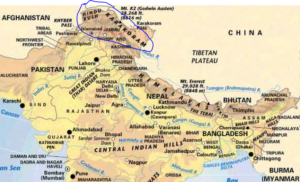In news : The Recently released climate change report on Indian region stated that Snowfall over the higher reaches of the Hindukush Himalayan mountain ranges has been increasing in recent decades
Assessment of Climate Change over the Indian Region report: Key findings
- Report published by the Ministry of Earth Sciences in June 2020
- As per the report, Several areas of Hindukush Karakoram Himalayas have experienced a declining trend in snowfall and also retreat of glaciers in recent decades. In contrast, the high-elevation Karakoram Himalayas have experienced higher winter snowfall that has shielded the region from glacier shrinkage
- This was the first such report prepared for India.
- The report further notes that the overall climate along the Hindukush Karakoram region is undergoing warming at a higher rate during the winter season as compared to other seasons. Besides, the warming reported from this region is higher than global mean temperatures
- The decadal warming trend recorded over these ranges from 1951 to 2014 was 1.3 degree Celsius. This is a rise from 0.16 degree Celsius recorded from 1900 to 1950, when global warming was less pronounced.
- The Climate Assessment report has forecast an increase in annual mean surface temperature by 2.2 degree Celsius during 2040 – 2069 and a further increase by 3.3 degree Celsius during 2070 – 2099, along these ranges.
- It also highlighted that weather dynamics is intricate in the Himalayan region, arising due to extensive interactions of tropical and extratropical weather systems
- The report mentioned that the Himalayas have been warming at a faster rate than the rest of Indian land mass during 1951 – 2018
- The snow cover over the Hindukush Karakoram ranges has shown varying tendencies from 1980 to 2018, with moderate declining rate observed since 2000.
- The report added that about 50 per cent of the region’s annual precipitation occurs during winter months, with snowfall being the primary source for water for the rest of the dry months of the year. Monsoon causes precipitation during summers too.
- It predicted that due to this warming trend, there is an expected increase in the precipitation projected over the region. There will be a significant increase in extreme precipitation over the Hindukush Karakoram region, with maximum consecutive five-day precipitation events
About Hindukush Karakoram Ranges
- The Hindukush Karakoram ranges, along with the Tibetan Plateau, are the main drivers of the world’s strongest monsoon systems, the Indian Summer Monsoon.
- Hindu Kush:
- It divides the valley of the Amu Darya (the ancient Oxus) to the north from the Indus River valley to the south.
- The Hindu Kush is one of the great watersheds of Central Asia, forming part of the vast Alpine zone that stretches across Eurasia from east to west.
- It runs northeast to southwest and divides the valley of the Amu Darya (the ancient Oxus River) to the north from the Indus River valley to the south.

- Karakoram Range:
- It is the great mountain system extending some 300 miles (500 km) from the easternmost extension of Afghanistan in a southeasterly direction along the watershed between Central and South Asia.
- The Karakorams are part of a complex of mountain ranges at the centre of Asia, including the Hindu Kush to the west, the Pamirs to the northwest, the Kunlun Mountains to the northeast, and the Himalayas to the southeast.
- The borders of Tajikistan, China, Pakistan, Afghanistan, and India all converge within the Karakoram system, giving this remote region great geopolitical significance
- These ranges form the source to 10 major river systems in Asia, supporting drinking water, irrigation and power supply to 1.3 billion people in the continent.
- Major Indian rivers which replenish due to the melted snow are Indus, Ganges and Brahmaputra.
- After the North and the South poles, the Hindukush – Karakoram ranges, along with the Tibetan Plateau, hold the largest reserves of freshwater and are known as the ‘Third Pole’.
















